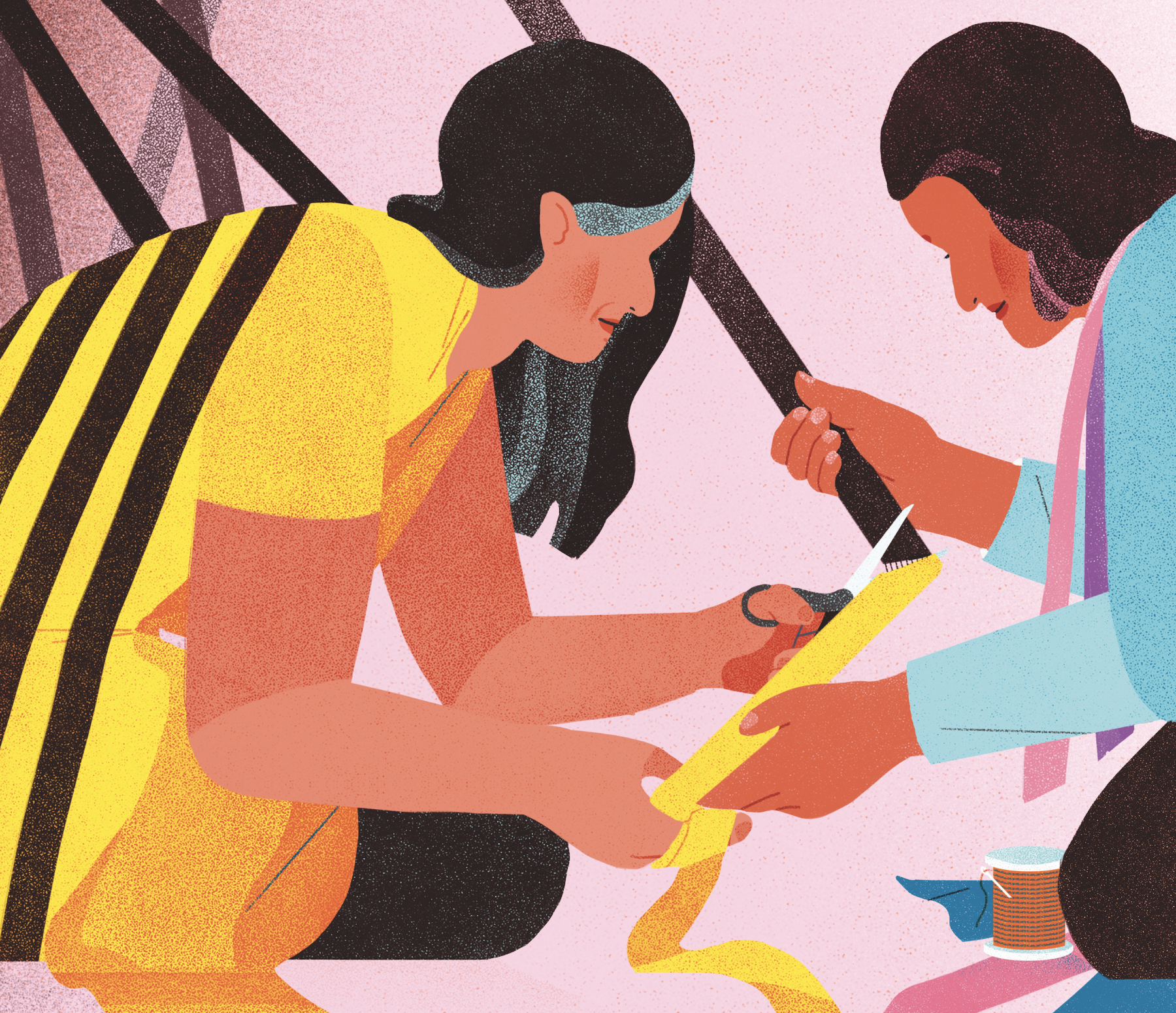On a Wednesday morning in December 2018, Uma* walks into the South Asian Women’s Centre (SAWC), giving the receptionist a tentative smile. The centre sits on the ground floor of an apartment building in Toronto’s west end. Its glass entrance is easy to miss, hidden behind lines of commuters waiting at the bus stop.
In the main activity room, Uma heads to a large table, strewn with lengths of vibrant fabric, tubs of multicoloured scissors and threads. She takes a seat at an unoccupied white Singer sewing machine; other seamstresses are already working away on their projects.
You may unsubscribe from any of our newsletters at any time.
Uma’s canary yellow salwar kurta — loose trousers and tunic paired with a scarf — contrasts with the 57-year-old’s paler-than-usual face. Over the lively chatter and the chukka-chukka-chukka-chukkas from the sewing machines, she tells a friend sitting next to her, “I’ve been feeling some pain in my chest and my upper back for the past few weeks.”
Two years ago, Uma was diagnosed with fibromyalgia, her body’s response to post-traumatic stress and depression. For Uma, abuse at the hands of her ex-husband has manifested itself as crippling pain, chronic fatigue and anxiety. “A sudden phone ring, or someone gesturing unexpectedly with their hands, is enough to trigger a long period of physical pain in my body,” explains Uma.
Despite these ailments, she finds comfort and sisterhood at SAWC. Uma first came to the centre 11 years ago, shortly after leaving a violent second marriage. Now the sewing sessions and other programs, including yoga and cooking classes, continue to be a weekly routine. “Coming here gives me hope and confidence in a country that’s still foreign to me,” she says.
The non-profit has been sensitively and respectfully helping South Asian immigrant women for decades. Through its programs, SAWC is uniquely positioned to serve a key role in helping Uma and other survivors of intimate partner violence (IPV) — an issue in the South Asian community that is shrouded in secrecy, stigma and shame.
Globally, violence against women has reached epidemic levels. And since the #MeToo movement, society is becoming increasingly aware of the gender-based violence that women face — including at the hands of their partners. The World Health Organization estimates that one in three women experience IPV, which it defines as “acts of physical aggression, psychological abuse, forced intercourse and other forms of sexual coercion, and various controlling behaviours such as isolating a person from family and friends or restricting access to information and assistance.”
Officially recognized as a public health issue in Canada, IPV accounts for a quarter of all crimes reported to the police. Few Canadian studies have looked specifically at the South Asian community, a portmanteau that clubs together a heterogeneous group of people from India, Pakistan, Sri Lanka, Bangladesh and Nepal. But the studies that do exist suggest similar rates. According to a McMaster University survey conducted among South Asians in southern Ontario, for example, one out of every five women was a victim of IPV in 2015. Uma’s own life story would bear out that statistic.
More on Broadview: The biggest threat to women in South Africa is their partners
Born and raised in northern India, Uma was widowed at 29 when her first husband died of cancer. She found herself alone with the responsibility of raising two young daughters. Uma’s father decided that her married older sister would become a proxy mother to Uma’s baby, and Uma would raise her oldest, Mona*, who was just three at the time.
In a country where widows are, to this day, considered bad omens and mandated to wear white sarees as a mark of their misfortune, Uma had little hope for her future, so she agreed to her father’s directive. She managed to find work as a receptionist in a friend’s company to support herself and Mona.
As Mona grew up, she wanted her mother to remarry and find happiness, and she created an online profile for Uma on a matchmaking site. Propositions poured in, and Uma settled on a South Asian Canadian man who worked for a large bank in Toronto. Uma felt he promised a better future than the other potential partners. After six months of online courtship, he travelled to India so the couple could meet.
Then 45, Uma had misgivings when she first set eyes on him at the airport. Seven years older than Uma, he seemed ill at ease and unsocial. “I felt a slight knot in my stomach,” she remembers. “And in that moment, I wanted to turn back and go home without talking to him. As he approached me, the knot in my stomach only grew tighter.”
But she dismissed her apprehensions and agreed to the marriage out of a sense of duty toward her daughters and respect for her aging parents. “I thought my daughters and I would find more security with him. In Toronto, I would live far away from the scrutiny of my relatives in Delhi, and my daughters would get a Western education with better marriage prospects, when their time came,” she explains.
Canada’s immigration services granted Uma and her two daughters permanent residency under the “Family Class,” a category reserved for elderly parents, dependent children and partners. Uma’s youngest daughter refused to move, but 24-year-old Mona agreed. The mother-daughter pair made the 20-hour journey to Toronto in 2008.
Within the first few days of their arrival, Uma’s husband started to prove her misgivings. Anger dominated every verbal exchange both in private and in public. He reprimanded her and Mona in the middle of a mall, at the grocery store or in the immigration office. Once at a government office, where she and Mona were applying for social insurance cards, “he started scolding us in front of the officer. He got angry with Mona. He screamed that she had no manners, that she didn’t bring the correct papers, that she was ungrateful,” Uma recalls.
“I felt like I was on an alien planet, where everyone knew what to do and where to go, except me.”
Uma
He’d mock both Uma and Mona for speaking English with an Indian accent. He accused mother and daughter of freeloading. He rationed their food and controlled their expenses, claiming he had the right to do so since he’d sponsored their permanent residency and passage to Canada.
Fed up, Uma looked for work. But with no Canadian experience, she could find only minimum-wage jobs lugging heavy boxes in factories or Indian grocery stores. She started losing weight due to fatigue and frequent high fevers. She didn’t last more than a couple of months at each workplace. Mona had better luck and landed a part-time sales position at a mall, but this made Uma’s husband even more controlling.
He kept raising his hands to hit Mona, grasping bottles, coffee mugs or anything else he found handy, but he would stop just short of making contact. Uma kept shielding her daughter, never knowing when his abuse would become physical. Looking back, she thinks he did not want to leave marks on Mona that could be used against him in court.
Every day, mother and daughter lived in fear. And every night, Mona slept with a knife under her pillow. “He could scare me easily with his raging gestures,” says Uma. “But my daughter was young. She didn’t care for his tantrums. He didn’t want her to stay with us. He would call her all kinds of dirty names every chance he got. He thought he could dominate me better if he got rid of Mona.”
As a new immigrant, Uma had no family or friends in Canada to turn to. “Everyone in Toronto seemed bigger, smarter, different,” Uma remembers. “Everyone looked down at me, as though I was out of place and in their way. I felt like I was on an alien planet, where everyone knew what to do and where to go, except me. Even though I spoke English, no one understood what I said.”
Uma felt isolated and afraid with no hope of escape. When arguments with her husband reached a crescendo, she’d ask him if she should jump off the balcony of their 10th-floor condo. This level of desperation isn’t uncommon — nearly 38 out of every 1,000 South Asian immigrant women attempt suicide in North America every year, according to a recent study.
“[South Asian women] now hold the dubious distinction of having the highest rates of suicide, attempted suicide and self-harm among young women than any other ethnic group living in Western countries,” writes Aruna Papp in her 2011 research paper, “Suicide Among Young Women of South Asian Origin.”
Papp is a South Asian Canadian abuse survivor, educator and advocate based in Ontario. Her research has shown that for abused women like Uma, suicide sometimes feels like the only way out. Leaving isn’t an obvious option, as that would be a sign of their failure to keep the marriage together. “In South Asian culture, the family is viewed as a collective in which the group’s needs are seen as more important than the needs and desires of the individual members,” writes Papp in her paper. “A notable characteristic of such collectivist societies is their concern with maintaining a harmonious relationship within their clan or community.”
Uma did end up making one friend after she arrived in Canada — a neighbour who heard the violence through the thin condo walls. After seven months, the neighbour helped Uma and Mona find the courage to leave and seek help at a legal aid office. And that eventually led Uma to walk through the doors of SAWC.
In 1979, a group of South Asian social workers in the Greater Toronto Area recognized there weren’t any culturally sensitive settlement and counselling services available for newly immigrated South Asian women (or men, for that matter). So they came together and founded SAWC.
In particular, the non-profit wanted to help women fleeing violent situations. As young brides and new Canadians, South Asian women were susceptible to domestic violence for a variety of reasons: power dynamics, loss of identity, isolation, gender roles, shame, fear of losing their children, economic challenges and the need to protect family honour. They also faced racism and exclusion from the dominant Canadian culture. “This exists even now. It may have changed to some degree, but it still exists,” says Kripa Sekhar, who’s been executive director of SAWC since 2004.
SAWC has tailored its programs in response to these issues. The centre’s core settlement services are provided in at least 16 different South Asian languages. The staff also offers counselling and crisis intervention. A tax clinic assists women who are at risk of financial abuse. The wellness programs, run in partnership with the Canadian Mental Health Association, address marital stress, cultural isolation and depression. SAWC also plays a crucial role in teaching and empowering South Asian women to recognize signs of abuse.
Since 1982, the centre has seen an increasing number of women among its clients who are IPV survivors. SAWC’s 2015-16 annual report specified that in the preceding two years, it had served 875 women fleeing incidents of abuse, and many cases were still ongoing.
South Asian women were susceptible to domestic violence for a variety of reasons: power dynamics, loss of identity, isolation, gender roles, shame, fear of losing their children, economic challenges and the need to protect family honour.
A decade ago, Tina* was one of those women. She was about 30 when she arrived at the centre to meet with one of SAWC’s settlement and mental health counsellors. Abandoned, alone, thin and pale, she stood trembling with a pillow tucked under her arm. She was looking for a safe place to sleep after several nights of staying awake in fear. For three years, Tina’s then-husband had carried out a daily regimen of beatings on her and their three children.
Before immigrating to Canada, he had worked as a civil engineer in Libya, earning a good living. However, Canada doesn’t often accept foreign credentials of highly educated immigrants, and Tina’s husband failed to find an equivalent job in Toronto. Instead, he was forced to work minimum-wage part-time jobs. Tina and her children bore the brunt of his frustration.
They rented a small, damp basement apartment where the landlords frequently called the police to mitigate the violence they overheard. Eventually, Tina filed for divorce and was granted custody of their kids. “My husband threw me out on the streets. I was all alone with three hungry children and nowhere to go,” she remembers.
She ended up in one city shelter after another, bouncing around as she waited for a subsidized housing unit to open up. At one point, she even considered returning to her ex-husband to avoid homelessness. Rentals were costly in Toronto back then, and the situation has only worsened. The wait time for government-subsidized units is now up to 10 years long.
Luckily, after a year in shelters and with help from SAWC, Tina found a subsidized apartment — and she is thankful to the counsellors who have assisted her along the way. “Because of SAWC, I now have the confidence I need to go about my day as normally as possible,” she says.
Beyond helping survivors, SAWC is also working to educate Canadian society about IPV in South Asian communities. News reports sometimes stereotype this genre of violence in South Asian families, labelling it a “cultural issue.” In doing so, the onus is shifted to the minority community to take care of its own. “That’s the easy route to take because then you don’t have to pay attention to the broader conversation about gender,” says Priyanka*, a Toronto-based social worker who is an abuse survivor herself.
As the Canadian Domestic Homicide Prevention Initiative elucidates: “These forms of violence…must be seen as forms of gender-based violence rooted in patriarchy, and not as issues associated with any one culture or religion.”
When a South Asian man kills his wife and/or children after years of abuse, Canadian reporters often call the incident an “honour-based” killing, which the RCMP defines as a crime committed by someone who perceives that the murder “was necessary or acceptable to protect or defend the honour of the family or the community.”
“When in fact every murder that takes place, every murder of a woman by a man, is, generally, to do with the man’s ego and power and control,” comments Sekhar, SAWC’s executive director. To minimize IPV in the context of honour and not call it murder is to grant it legitimacy. “[This is] not acceptable to women from South Asian communities because murder is murder. There is nothing honourable about it.”
In the sewing group, Uma helps her friend undo the stubborn hem of a sweater. Then she goes back to her own project, a half-finished pair of pyjamas she’d cut out of a donated saree.
Uma’s divorce came through after six years of separation from her husband. SAWC’s counsellors helped her and Mona find an apartment through the centre’s settlement program. Mona has earned her bachelor’s degree, and a few years ago she and Uma went back to India for her younger sister’s wedding.
In time, Uma has slowly learned to call Toronto home. She is a keen follower of Canadian politics and grateful that at SAWC she can communicate with women from her own culture, in her own language. At the centre, she has, over the years, met several women like herself who were fleeing violent homes. She feels fortunate that by sharing her story of survival, she can help them cope.
As she works away at her pyjamas, she furrows her brow, thinking about how to gather the stitches to create pleats below the waistband. It is tricky, but she knows her way around it. “Uma is an expert seamstress!” proclaims a member of the group.
Uma smiles and quietly whispers, “I don’t know what I’d do if I hadn’t found SAWC.”
This story first appeared in Broadview’s November 2019 issue with the title “Mending lives.”
Broadview is an award-winning progressive Christian magazine, featuring stories about spirituality, justice and ethical living. For more of our content, subscribe to the magazine today.














